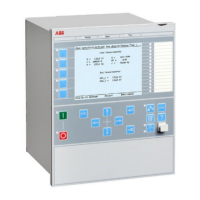Section 9 Establishing connection and verifying the
IEEE C37.118/1344 communication
9.1 Overview
GUID-EFD77C28-6F7C-4277-8C7E-30E78CC8EFAD v3
The IED can support synchrophasor data communication via IEEE C37.1
18 and/or
IEEE1344 with maximum 8 TCP clients and 6 UDP client groups, simultaneously.
The rear OEM ports are used for IEEE C37.118/1344 communication. The same
ports can also be used for substation bus (IEC 61850-8-1) communication and
process bus (IEC/UCA 61850-9-2LE) communication where applicable.
In order to establish a connection between PMU and a TCP/UDP client (PDC
client), an Ethernet communication link (e.g. optical fiber) shall be available and
the required parameters on both PMU and the TCP/UDP client shall be set. For the
purpose of this section, an Open PDC tool (PMU Connection Tester) installed on a
PC is used as the TCP/UDP client.
9.2 Setting the PMU station communication (PMU
Report)
GUID-B8DCD7BA-AEBA-4977-89D4-2F18ECE34A2F v1
1. Check the settings for the PMU Report parameters by navigating to: Main
menu/Configuration/Communication/Station communication/phasor
measurement/PMU Report/PMUREPORT:1
1.1. Make sure that the operation of at least one PMU instance (e.g. PMU1)
is On.
1.2. Enable sending the frequency data by setting the parameter
SendFreqInfo to On.
2. Check the operation of the required phasor channels (PHASORREPORT) by
navigating to: Main menu/Configuration/Communication/Station
communication/phasor measurement/PMU Report/PHASORREPORT:x.
1MRK 505 378-UEN A Section 9
Establishing connection and verifying the IEEE C37.118/1344 communication
Line differential protection RED670 2.2 IEC 73
Commissioning manual

